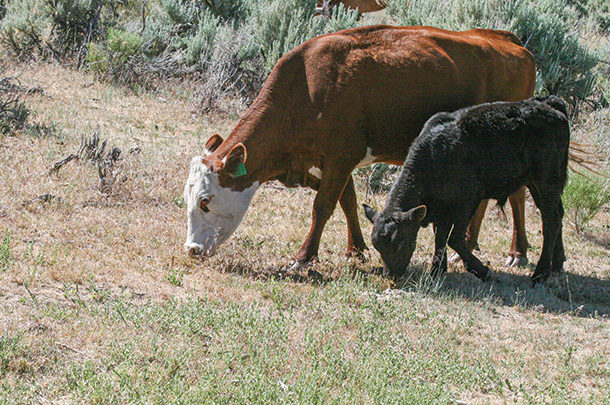Spring is a beautiful time of year that brings renewed hope and optimism for production agriculture. The list of to-dos is endless with many folks either finishing up or in the midst of spring calving and preparing for the next breeding season, as well as field work and attempting innumerable other projects.
Complicate the busy season with constantly rising input prices and a severe drought over much of the U.S., and we certainly have no shortage of things to think about this spring.
At the time of this writing (mid-March), drought conditions persist across the central and western regions of the country, including many large areas with significant beef cow populations. Cow-calf producers are undoubtedly well acquainted with drought, and many just accept it as part of the cattle business, but this spring is a critical time to rethink your management plan.
For folks experiencing drought in recent months, these points may serve as discussion for ways to adapt your plan. To those blessed with moisture, consider these topics and what you would do should conditions change. Strategic management may enable us to persevere through a drought longer without having to liquidate breeding females.
Drought planning
Do you have a defined drought management plan in place? This can be as simple or as complex as you want it to be, but the point of having a defined plan is to have a guide to help make proactive, informed decisions instead of reactive, circumstantial decisions. This ensures you use sound judgment, logic and facts instead of emotions and feelings.
Start by understanding what your average annual precipitation is for your location and by what date in the growing season you need to receive a certain percentage of that precipitation for normal forage production. Having a time component and defined precipitation thresholds as part of your plan helps you avoid delaying decisions, and you can implement mitigation strategies with more confidence. Essentially you can have the conversation: “If we don’t get X amount of moisture by Y date, then we need to do A, B and consider C.”
Yes, drought conditions may alleviate quickly, but having a plan in place and sticking to it enables us to make decisions that are focused on long-term productivity of the operation and not just on short-term gains or conveniences.
Strategic management
If you need to delay turnout or reduce stocking rate, consider which groups of cattle are most easily managed alternatively. If you have both a fall- and spring-calving cow herd and you need to reduce stocking rate, consider reserving available grass for spring-born pairs while maintaining dry gestating cows off pasture and feeding a mixed ration or another source of forage.
The same could be done for replacement heifers, which consume less forage than mature cows or cow-calf pairs and would ultimately be a less expensive and easier animal to maintain in a drylot/pen setting. Cows that were marked as potential culls this coming fall should be managed separately to free up forage for the most desirable females here at the beginning of the growing season.
Preg-check earlier
Early pregnancy diagnosis identifies non-pregnant females and allows us to change our management plan with them to save forage. This is a useful tool for replacement heifers where open females can be marketed as a yearling sooner than we typically might otherwise, often at a time with strong economic value. This way the replacement heifer enterprise can serve a drought management purpose by conserving more forage for the core of the cow herd, similar to managing a stocker enterprise alongside a cow herd.
Early wean
Early weaning is one of the most effective drought management strategies from a forage conservation standpoint because it reduces forage intake approximately 30%-40% from a combination of both the cow and calf. Thus, for every 2.5 days the calf is weaned, it saves enough forage for approximately one more day of grazing for the cow.
Not only can you extend the grazing season by early weaning, but you also allow the cow an opportunity to gain body condition with little or no supplemental feed. Calves weaned at 120-150 days of age will do well, but you need to consider what your nutrition and marketing plan is after weaning. Certainly, one can wean them at less than 120 days of age, but it takes quality feed and good, tight facilities that can handle small calves.
Test forages
Testing forages is always advised, but its importance becomes magnified when forages are limited and expensive. Our goal is to minimize supplemental feed costs and use raised forages efficiently. Accurate forage analyses can not only help determine how much we need to supplement or what other feeds we need for our ration, but it also identifies situations where additional supplementation is not needed. Price supplements on a cost-per-unit-of-nutrient basis and understand what nutrients they are providing. Stay aware of the ingredient market and opportunities to buy on discount or “fire sales” as a form of protecting against higher future prices. Consider partnering with a neighbor on feed loads to help save on delivery costs.
Much has been learned over the last several years about our ability to manage cow herds in drylot or confinement settings, and it can be a great fit for some operations. Producers must have adequate facilities to maintain cows and calves in and be able to accurately deliver a ration with sufficient bunk space. Cows and calves can perform well on limit-fed rations where intake is less than cattle typically consume, but it’s designed to provide a given level of protein and energy intake.
For some, the best option may be to work with a nearby backgrounding or finishing yard and having them provide feed and care until sufficient forage is available. There needs to be a great deal of trust and communication between parties for this to be successful. Custom yards are just as affected by drought conditions in terms of forage prices and availability, but they typically have access to other feeds and can effectively deliver mixed rations to maintain the cow herd. Keep in mind that facilities designed for growing and finishing cattle are not always ideal for cows and their calves at side.
Ammonia use
Anhydrous ammonia treatment of low-quality forages is one technique that has application during drought conditions when feeds are limited. The ammonia reacts with water to break the bonds of the fiber components, resulting in a forage that is more digestible and ultimately contributing to an increase in intake and energy available to the animal. With current anhydrous ammonia prices, it may not be as cost-effective if you can source other protein or energy sources, but it can work if you are dealing with very limited and poor-quality forages.
Drought is part of cattle production and is present in some major cattle regions each year. While not all the management considerations discussed here apply to every operation, every operation needs to have a drought mitigation plan. It is better to have a plan and never have to use it than to be forced into making decisions on short notice.









